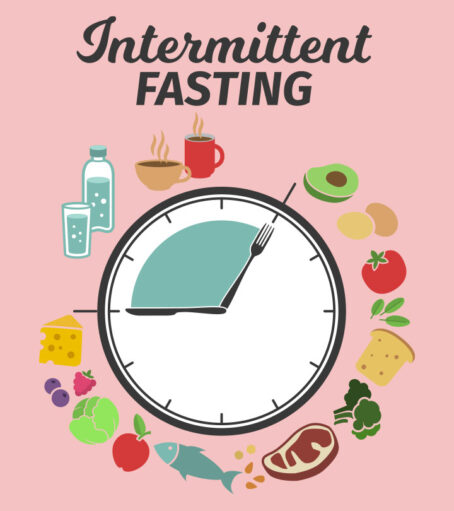Intermittent fasting is an eating pattern during which you refrain from consuming any calories for an extended period of time. Usually, this period lasts between 12 and 40 hours.
Water, coffee, and other calorie-free beverages are allowed during the fast, but no solid foods or calorie-containing drinks are permitted.
How does intermittent fasting work?
It is said that after hours without food, the body exhausts its sugar stores and starts burning fat. He refers to this as metabolic switching. So intermittent fasting works by prolonging the period when your body has burned through the calories consumed during your last meal and begins burning fat.
Intermittent fasting benefits
- Thinking and memory. Studies discovered that intermittent fasting boosts working memory in animals and verbal memory in adult humans.
- Heart health. Intermittent fasting improved blood pressure and resting heart rates as well as other heart-related measurements.
- Physical performance. Young men who fasted for 16 hours showed fat loss while maintaining muscle mass. Mice who were fed on alternate days showed better endurance in running.
- Diabetes and obesity. In animal studies, intermittent fasting prevented obesity. And in six brief studies, obese adult humans lost weight through intermittent fasting.
- Tissue health. In animals, intermittent fasting reduced tissue damage in surgery and improved results.
Ways to do intermittent fasting
Meal skipping
This flexible approach to intermittent fasting may be good for beginners. It involves occasionally skipping meals.
People can decide which meals to skip according to their level of hunger or time restraints. However, it is important to eat healthful foods at each meal.
Meal skipping is likely to be most successful when individuals monitor and respond to their body’s hunger signals. Essentially, people using this style of intermittent fasting will eat when they are hungry and skip meals when they are not.
This may feel more natural for some people than the other fasting methods.
A weekly 24-hour fast
Fasting completely for 1 or 2 days a week, known as the Eat-Stop-Eat diet, involves eating no food for 24 hours at a time. Many people fast from breakfast to breakfast or lunch to lunch.
People on this diet plan can have water, tea, and other calorie-free drinks during the fasting period.
People should return to normal eating patterns on the non-fasting days. Eating in this manner reduces a person’s total calorie intake but does not limit the specific foods that the individual consumes.
A 24-hour fast can be challenging, and it may cause fatigue, headaches, or irritability. Many people find that these effects become less extreme over time as the body adjusts to this new pattern of eating.
People may benefit from trying a 12-hour or 16-hour fast before transitioning to the 24-hour fast.
Alternate day fasting
There are several variations of the alternate day fasting plan, which involves fasting every other day.
For some people, alternate day fasting means a complete avoidance of solid foods on fasting days, while other people allow up to 500 calories. On feeding days, people often choose to eat as much as they want.
One studyTrusted Source reports that alternate day fasting is effective for weight loss and heart health in both healthy and overweight adults. The researchers found that the 32 participants lost an average of 5.2 kilograms (kg), or just over 11 pounds (lb), over a 12-week period.
Alternate day fasting is quite an extreme form of intermittent fasting, and it may not be suitable for beginners or those with certain medical conditions. It may also be difficult to maintain this type of fasting in the long term.
Fast for 12 hours a day
This type of intermittent fasting plan may be a good option for beginners. This is because the fasting window is relatively small, much of the fasting occurs during sleep, and the person can consume the same number of calories each day.
The easiest way to do the 12-hour fast is to include the period of sleep in the fasting window.
For example, a person could choose to fast between 7 p.m. and 7 a.m. They would need to finish their dinner before 7 p.m. and wait until 7 a.m. to eat breakfast but would be asleep for much of the time in between.
Fasting for 16 hours
Fasting for 16 hours a day, leaving an eating window of 8 hours, is called the 16:8 method or the Leangains diet.
During the 16:8 diet, men fast for 16 hours each day, and women fast for 14 hours. This type of intermittent fast may be helpful for someone who has already tried the 12-hour fast but did not see any benefits.
On this fast, people usually finish their evening meal by 8 p.m. and then skip breakfast the next day, not eating again until noon.
Is intermittent fasting safe?
Some people should steer clear of trying intermittent fasting:
- Children and teens under age 18.
- Women who are pregnant or breastfeeding.
- People with diabetes or blood sugar problems.
- Those with a history of eating disorders.
Keep in mind that intermittent fasting may have different effects on different people. Talk to your doctor if you start experiencing unusual anxiety, headaches, nausea or other symptoms after you start intermittent fasting.
 Dabur Sitopaladi Churna_DABUR INDIA
1 × 95.00 ₹
Dabur Sitopaladi Churna_DABUR INDIA
1 × 95.00 ₹ Vasu Zeal Kid Drop
1 × 61.75 ₹
Vasu Zeal Kid Drop
1 × 61.75 ₹ Vasu Zeal Herbal Granules
1 × 118.75 ₹
Vasu Zeal Herbal Granules
1 × 118.75 ₹ SRI SRI TATTVA Honey
1 × 134.40 ₹
SRI SRI TATTVA Honey
1 × 134.40 ₹ Oxyspray Nasal Spray_Zydus Cadila
1 × 228.00 ₹
Oxyspray Nasal Spray_Zydus Cadila
1 × 228.00 ₹ Zandu Ayurvedic Cough Syrup 8ml sachet
1 × 4.70 ₹
Zandu Ayurvedic Cough Syrup 8ml sachet
1 × 4.70 ₹ HIMALAYA Koflet-SF Linctus PACK of 2
1 × 133.00 ₹
HIMALAYA Koflet-SF Linctus PACK of 2
1 × 133.00 ₹ Hamdard Sualin 400 tablets
1 × 380.00 ₹
Hamdard Sualin 400 tablets
1 × 380.00 ₹
 Dabur Sitopaladi Churna_DABUR INDIA
Dabur Sitopaladi Churna_DABUR INDIA  Vasu Zeal Kid Drop
Vasu Zeal Kid Drop  Vasu Zeal Herbal Granules
Vasu Zeal Herbal Granules  SRI SRI TATTVA Honey
SRI SRI TATTVA Honey  Oxyspray Nasal Spray_Zydus Cadila
Oxyspray Nasal Spray_Zydus Cadila  Zandu Ayurvedic Cough Syrup 8ml sachet
Zandu Ayurvedic Cough Syrup 8ml sachet  HIMALAYA Koflet-SF Linctus PACK of 2
HIMALAYA Koflet-SF Linctus PACK of 2  Hamdard Sualin 400 tablets
Hamdard Sualin 400 tablets 